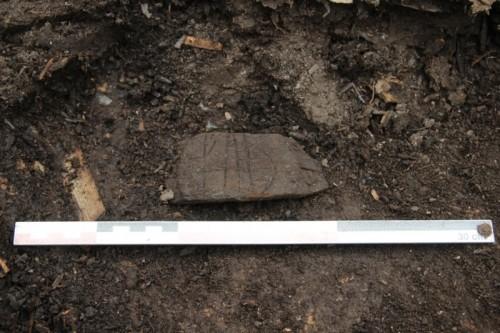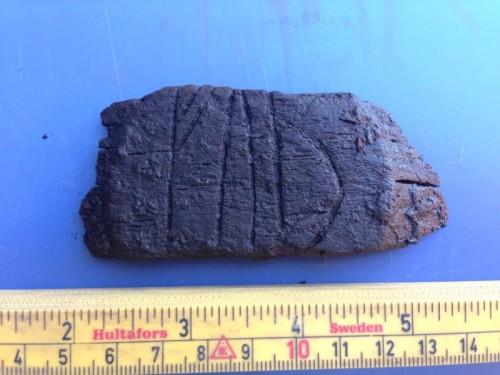Source - http://theforeigner.no/pages/news/middle-ages-tagging-found-in-oslo/?
With three letters, the message from the past is short and may not pass today’s moderators.

The three letters shown could be informative or naughty. Rune carvings on site Photo: Norwegian Institute for Cultural Heritage (NIKU)
Archaeologists in the Scandinavian capital have recently come across an indecent side of Norwegian Medieval life. The hard discovery, made by the Norwegian Institute for Cultural Heritage Research (NIKU) staff, was made in connection with the development of the Follo railway construction in Oslo.
Human bones being found that tell something about life in the past is one thing, but a message found from a previous Ages has a surprising side.
A piece of wood with three double entendre characters carved on it was discovered. Fuþ are the first three in the Rune alphabet, but also the Old Norse word for the female genitalia, reports Aftenposten.
“The fact we find this interesting has to do with that scripture means we can get closer to the ancients. It’s a snapshot of something a person from medieval times scored into a piece of wood. But as for this word, it's as simple as that dirty language sells,” archaeologist Egil Marstein Bauer at NIKU tells The Foreigner.
Hard work

Carvings in the rune Norwegian Institute for Cultural Heritage (NIKU)
“Runes are fun. You feel that you get closer to the people. Here, someone sat and carved this. I thought that it was a rune ABC when I first saw it. Though others have reminded me that it may have a completely different meaning,” Mr Bauer comments to Aftenposten.
People were bold in the Late Middle Ages when they carved runes on bones and pieces of wood, much like today's graffiti on walls.
According to Karin Fjellhammer Seim, retired professor of Old Norse language and literature at the Norwegian University of Science and Technology (NTNU) in Trondheim, rune carvers could be randy and vicious when women were portrayed as nymphomaniac ‘fudorgs’ (‘fud’ in Old Norse is a word for an opening in the body).
But it was not just women’s genitalia that were used as a swearword. Examples are found around the harbour area in western Norway’s Bergen in particular.
“There are many rune sticks that are just as vulgar and are about the man’s genitalia. They are so [rude] that it would probably not even be permitted to be published in a modern newspaper,” Ms Seim says.
Pillow talk?
Rudeness is not unique to archaeology. In 2003, Norway tabloid Dagbladet printed some of the "dirty talk" reminiscent of what might be found on the walls of a public restroom.
About the latest discovery, NIKU’s Egil Marstein Bauer comments that “we know that the runes could be very obscene and deal with everything from adultery to sodomy.”
“But I can’t say whether the clean or dirty interpretation [regarding the double entendre find] should be used here."
Moreover, archaeologists have also found bones that can tell researchers what people ate, what diseases they had, and whether they had specific parasites in their system.
Finding mercury in the soil around the skeleton may indicate that the person was treated for syphilis. So, they did not just talk.